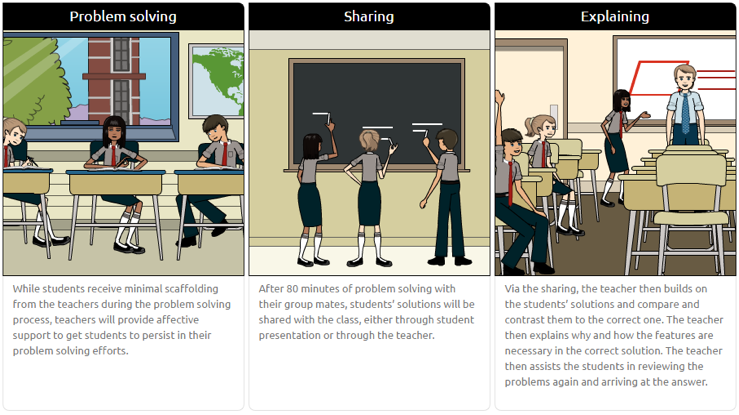Productive Failure
Productive Failure: Leveraging Students’ Ideas, Making the Learning Process Productive
- Helps students learn and better understand complex math problems
- Improves teachers’ understanding of how students learn and what students know
- Allows teachers to catch students’ misconceptions and connect students’ prior knowledge to new concepts
-
Regardless of ability level, students will develop critical knowledge and skills, learn to persist amidst challenges, and hone their collaboration skills.
 Why Productive Failure?
Why Productive Failure?
Productive Failure allows students to generate and explore their own solutions to new and complex math problems before actually being taught the “correct” solution. They may not get the “right” answer at first, but this floundering can pave the way for deeper learning.
Through a JC Mathematics package that covers key topics in Statistics, the Productive Failure research project provides a professional development program that engages teachers in designing, unpacking and building learning and problem solving skills in JC students.
 How Does Productive Failure Work?
How Does Productive Failure Work?
- Productive failure flips the commonly-held assumption that students are unable to solve complex questions unless a teacher scaffolds and demonstrates how it is done.
- The Productive Failure design taps on 4 interdependent core mechanisms:
- Using what students already know or think they know about a concept
- Identifying the important features of the concept
- Explaining why these features are important
-
Organising these explanations into a framework to understand the concept
 How Did Students Respond?
How Did Students Respond?
- Students in the Productive Failure classrooms outperformed their counterparts in the traditional Direct Instruction classrooms in solving problems that require conceptual understanding and those that were not targeted in the formal curriculum.
- Students of different mathematical ability profiles were all able to generate multiple solutions to the complex problems. Hence, the teaching method is suitable for students of different ability levels.
-
The more solutions students could come up with, the more they will benefit through learning using this teaching method.
 How Can Teachers Get Started?
How Can Teachers Get Started?
- Using the sample worksheets, the teacher plays a vital role in facilitating and supporting student-generated solutions.
- While students receive minimal scaffolding from the teachers during the problem solving process, teachers will provide affective support to get students to persist in their problem solving efforts.
- After 80 minutes of problem solving with their group mates, students’ solutions will be shared with the class, either through student presentation or through the teacher.
- Via the sharing, the teacher then builds on the students’ solutions and compare and contrast them to the correct one. The teacher then explains why and how the features are necessary in the correct solution.
-
The teacher then assists the students in reviewing the problems again and arriving at the answer.

Remember!
- Mind the hand-holding! Productive failure is not about getting the right answer right away. Allow and encourage your students to question, explain and elaborate on their solutions.
- Stretch your students! Try setting complex math questions that will leverage students’ formal and intuitive prior knowledge.
- Lead the consolidation! As the subject expert, you will be able to understand and explain the critical features, and help students put together and link their solutions to the targeted concepts.
 Related Links
Related Links
- ReEd Vol 2 2011, pg 3 “Productive Failure in Math” [PDF]
- ReEd Vol 14 2014, pg 3 “Designing for a Collaborative Future”[PDF]
 Research Projects
Research Projects
The following projects are associated with Productive Failure Research:
 Research Team
Research Team
To learn more about Productive Failure, please contact the Principal Investigator A/P Lee Ngan Hoe at nganhoe.lee@nie.edu.sg.
Principal Investigator
-
A/P Lee Ngan Hoe, Mathematics and Mathematics Education, NIE
Co-Principal Investigators
- Prof Manu Kapur, ETH Zurich, Switzerland (formerly of NIE)
-
A/P Katerine Bielaczyc, Clark University, USA (formerly of NIE)
Collaborators
- Mr Dennis Yeo, MOE
 Acknowledgments
Acknowledgments
This research on Productive Failure was funded by Singapore Ministry of Education (MOE) under the Education Research Funding Programme (DEV 03/14 MK) and administered by National Institute of Education (NIE), Nanyang Technological University, Singapore. Any opinions, findings, and conclusions or recommendations expressed in this material are those of the author(s) and do not necessarily reflect the views of the Singapore MOE and NIE.
This knowledge resource was written by Bernadine W. Sengalrayan in June 2017, updated by Ms Monica Lim on 4 January 2022.







